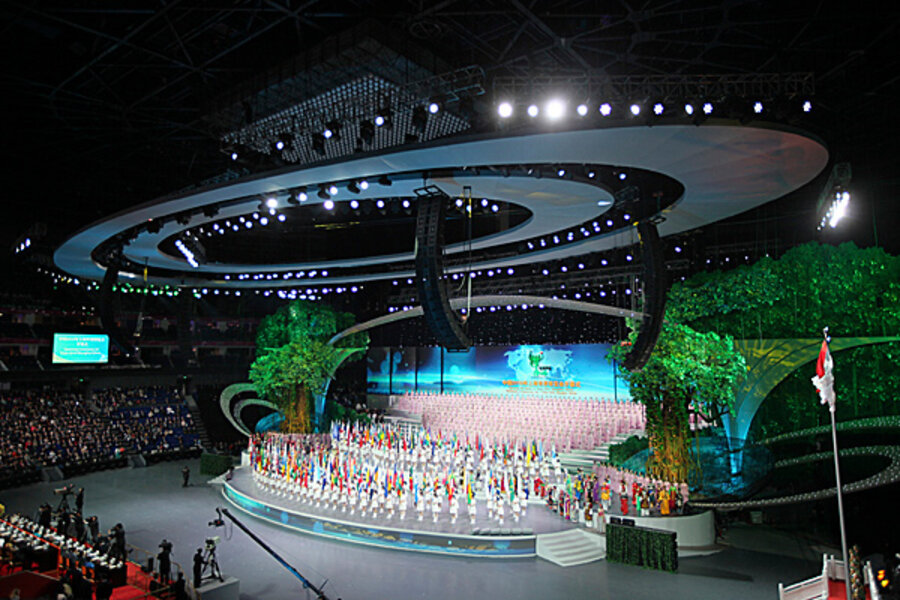As Shanghai Expo opens, construction workers still pounding nails and paving plazas
Loading...
| Shanghai, China
A day before China's Shanghai World Expo was due to open its gate to an estimated 700,000 visitors on Saturday, construction workers were still feverishly hammering, welding, painting, and paving against a seemingly impossible deadline.
Many were putting the finishing touches to national pavilions almost ready to receive the public. Others, though, were clearly too far behind schedule to make opening on Saturday a realistic prospect. The United States appeared ready – but the Indonesians looked as if they were struggling. The former Yugolsav republic of Macedonia did not even have its name sign up.
That so much remained to be done on the eve of the Expo, eight years after Shanghai was given the right to host it, was apparently the result of a mixture of factors. They ranged from the sheer scale of the enterprise – the largest World’s Fair ever held – to heavyhanded interference by the Chinese authorities, according to foreigners participating in the show and local analysts.
IN PICTURES: Shanghai World Expo 2010
At bottom, complained the manager of one pavilion who asked not to be identified, was the Chinese organizers’ insistence that only approved contractors on a city government list would be allowed to work on the site.
“They were irresponsible,” he charged, wiping his face clean of construction dust blowing in the wind from a nearby pavilion – still a shell whose walls had yet to be plastered. “The Chinese contractors took on too much work and they could not finish it on time.”
Struggles with contractors
At the same time, he and others involved in the Expo complained, some of the contractors used their privileged position to demand more money if they were to continue work. “This was a one month job,” he said. “But between the fights day and night with the contractors and the negotiations, it has taken four times as long.”
Some of the problems appear to have arisen because outsiders brought in to manage the construction of national pavilions are unaccustomed to dealing with Chinese builders, who have a reputation for cutting corners and requiring close oversight.
“A lot of the pavilions brought in people with no experience of working with Chinese contractors,” points out Adam Minter, an American journalist and blogger here who has followed preparations for the Expo closely. “That led to all kinds of problems and delays.”
“You need someone who knows how to work the system or you are working against the system,” said the events manager of one European pavilion.
Compounding such problems, said several foreigners planning their nations’ Expo activities, have been frustrating customs delays and unannounced changes in security measures that have repeatedly blocked workers and construction materials at the gates.
“There have been poor communications between the Expo organizers and pavilion directors,” complains the European official. “That has held things up.”
How will tourists rate US pavilion?
The US pavilion appeared ready to receive visitors, despite having been plagued by problems until recently. It remains to be seen, though, what the 70 million tourists expected at the Expo over the next six months will make of the American exhibit, which comprises three video shows and a collection of kiosks promoting the wares of the US companies that sponsored the pavilion.
A lack of such commercial sponsors cast doubts on US participation in the Shanghai Expo until as late as last summer. US legislation means that no government money may be used to fund Expo pavilions.
US Secretary of State Hillary Clinton, however, after Chinese officials had made it plain to her how displeased they would be by an American no-show, personally contacted major US corporations to rally their financial support and named Jose Villareal, a San Antonio lawyer who had earlier raised money for the Clintons’ political campaigns, to be Commissioner of the US pavilion. The $61 million needed to build and run the pavilion was eventually forthcoming.
Such behind-the-scenes maneuvers are of little concern to average Shanghai residents, who are more likely to note the way in which their city has been repainted and filled with flowers and – more lastingly – equipped with 10 new subway lines in the past five years. This has given the city the second-largest subway network in the world, after London.
Once known as “The Pearl of the Orient,” Shanghai was a rich and cosmopolitan trade hub in the 1920s and 1930s, before war with Japan, the civil war, and then the Chinese Communist revolution in 1949 led to an exodus of the city’s financial and industrial entrepreneurs and killed its prosperity.
Only with the economic reforms, which took root in Shanghai 20 years ago, has the city begun to reclaim its international status; the city fathers speak confidently today of their ambition to replace Hong Kong one day as Asia’s premier financial center.
“Now there is hope for the future,” says Li Tiangang, a historian of Shanghai at Fudan University here. “But Shanghai people still need to get used to dealing with new lifestyles and new technologies and with competition. That will happen gradually, and the Expo will help.”
Related:
China's Shanghai Expo 2010 – by the numbers
On eve of Shanghai Expo 2010, China finds 'soft power' an elusive goal
All China coverage





